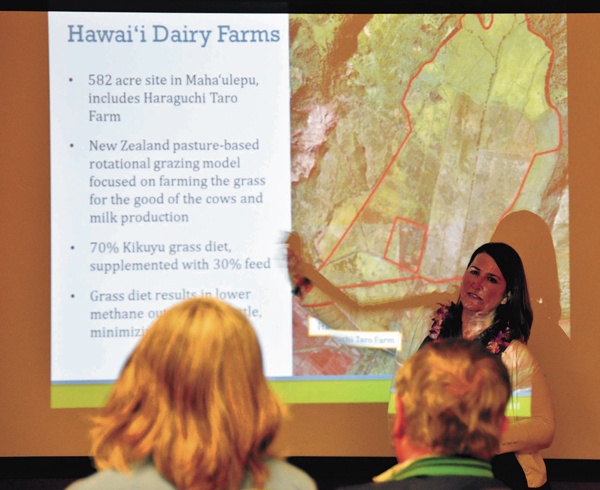WAIPOULI — A dairy farm could be operating on Kauai next year. Jim Garmatz, manager for Hawaii Dairy Farms, said their conservation plans have been approved by the Natural Resources Conservation Service. They are waiting approval and permits from the
WAIPOULI — A dairy farm could be operating on Kauai next year.
Jim Garmatz, manager for Hawaii Dairy Farms, said their conservation plans have been approved by the Natural Resources Conservation Service. They are waiting approval and permits from the Department of Health.
In a presentation at the Kauai Economic Development Board’s annual membership meeting Tuesday, Ann Hennessey, Ulupono Initiative director of communication, said the building permits are in progress, as are the irrigation systems and pasture development.
Hennessey said Hawaii Dairy Farms is planning a spring groundbreaking with the first of 1,800 head of Kiwi cross cattle arriving in late summer. The South Shore business could be in operation in 2015, she said.
“People want cheaper milk,” Hennessey said during the meeting at the Courtyard by Marriott at Coconut Beach. “But the goal of Hawaii Dairy Farms is to keep milk no more than the current prices.”
Hawaii Dairy Farms will utilize 582 acres in Mahaulepu, including the adjacent Haraguchi Taro Farm. Based on a New Zealand rotational grazing model, the cattle will feed on a 70 percent Kikyu grass diet, supplemented by 30 percent grain.
Randy Francisco, president of the Kauai Chamber of Commerce, said people have expressed concern about the smell of a dairy operation.
Those behind the project say it shouldn’t be a problem.
Hennessey, who visited some New Zealand operations, said grass-fed models emit less odor than the traditional, and more familiar, feed-lot models. She added that the dairy will be two miles away from its closest neighbor.
Garmatz said the odor is caused by the dry matter over a period of time and has been addressed in the dairy’s conservation plan, which was approved by the NCRS.
“What you are getting is top-of-the-line, eco-friendly,” Garmatz said.
Additionally, with the help of current technology, the waste will be integrated into the irrigation system for farming grass. Hennessey said if need arises, they will be able to shut down the effluent feed so it does not endanger the neighboring taro.
“We’re just grass farmers who happen to have (milk-producing) cattle,” Hennessey said.
Once operational, Hennessey said Hawaii Dairy Farms wants to work with the community in dairy education and will make an effort to work with high school students and the 4-H clubs.
Stu Burley was relieved to learn the Kauai cattle won’t have their tails bobbed as are some of the cattle which are prone to disease.
“We love animals,” said Hennessey. “Most of the animals live long happy and milky lives. Our cattle won’t have their tails cut.”


